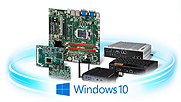
-
Step 1. Evaluation
- Embedded OEM Customer (OEM) contacts ADVANTECH, Microsoft Authorized Embedded Distributor.
- OEM obtains evaluation software or purchases a full version toolkit, if needed, from ADVANTECH.
-
Step 2. Sign CLA
- OEM Customer signs OEM CLA electronically.
-
Step 3. Development and Testing
- For FES & POSReady products, ADVANTECH provides the OPK (OEM Preinstallation Kits) for installation.
- For WES & CE products, OEM completes development of the master embedded image.
-
Step 4. Order License
- OEM contacts ADVANTECH to order Runtime Licenses and Associated Product Materials (APM).
- For FES and Server products, key is located on the COA or on a flyer that comes with the COAs.
- For WES, POSReady, and CE products, customer applies for product key from Microsoft on first order.
-
Step 5. Distribution
- Customer manufactures and distributes embedded systems with a Certificate of Authenticity and End User License Agreement as specified in the CLA.
Terms
Embedded OEM Customer License Agreement (OEM CLA)
Standard general terms and conditions that must be signed by and OEM in order to acquire Microsoft Embedded licensed products. See process below for more details.

Additional Licensing Provisions (ALP)
ALPs define product use rights and restrictions specific to each individual Microsoft Embedded licensed product. The ALPs can be found on the Associated Product Material (APM) packaging supplied by ADVANTECH, provided from a Microsoft Authorized Replicator (AR).
OEM Preinstallation Kit (OPK)
Kit that includes software based on the FES, Server or POSReady Operating System. In the Embedded Channel these products were designed as desktop products, however Microsoft has included licensing provisions or embedded restrictions which indicate how the product can be customized.
Runtime Licenses
Allows the OEM to replicate the Image based on the Microsoft Embedded Licensed Product, across a line of Embedded Systems. After ordering Runtime Licenses the OEM will receive the Associated Product Materials (APM) from ADVANTECH. APM are materials Microsoft may change from time to time but are required for distribution of the Embedded System. APM typically consists of two items—the COA (the label) and the ALP which include licensed product specific End User License Agreement (EULA) terms. Each Embedded System aimed for distribution requires a Runtime License.
Certificate of Authenticity (COA)
A serialized label, affixed to devices containing Embedded Microsoft operating systems. The COA is the primary antipiracy and product tracking tool and establish a proof of license. The product specific name is printed on the label. See section COA for more details.
Runtime Key (PID)
An alpha-numeric string, located on the COA or on a flyer that comes with the COAs, designated to each Microsoft product that provides a unique identification number. Runtime Keys are used to prove authenticity and flash an Image across a line of embedded systems.
End User License Agreement (EULA)
As the terms and conditions must be passed on to the end user, the EULA needs to be shipped together with the OEMs device. See section COA for more details.
FES
Abbreviation for “Professional for Embedded System”, the classic OS.
WES
Abbreviation for “Windows Embedded Standard”.











